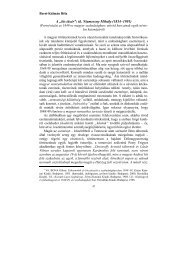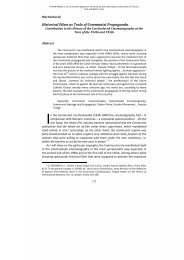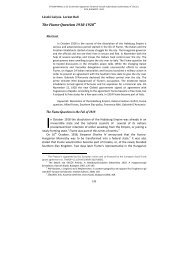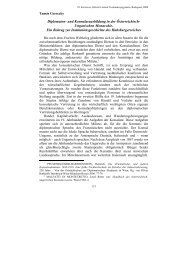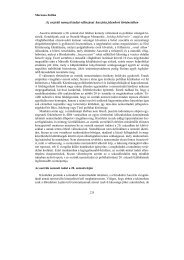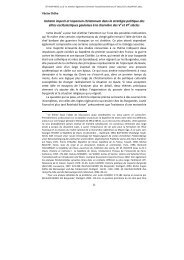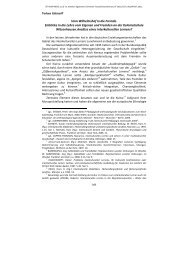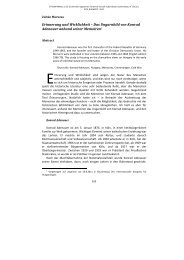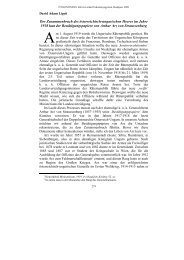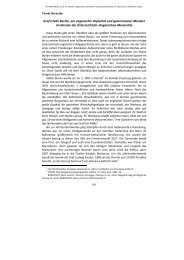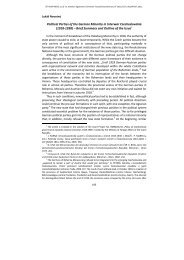The Molotov-Ribbentrop Pact - ELTE BTK Történelem Szakos Portál
The Molotov-Ribbentrop Pact - ELTE BTK Történelem Szakos Portál
The Molotov-Ribbentrop Pact - ELTE BTK Történelem Szakos Portál
You also want an ePaper? Increase the reach of your titles
YUMPU automatically turns print PDFs into web optimized ePapers that Google loves.
Different relations Reich had with Romania and Hungary. Romania might be<br />
situated somewhere between Poland and Czechoslovakia on one side and Hungary<br />
on another. Concerning Romanian relations with Soviet Union in June 1934 both<br />
countries recognised the borders and political independence, but the problem of<br />
Bessarabia was not solved. Two years later, in June 1936, both countries signed a<br />
mutual help agreement, but in August 1936 Soviet Union cancelled it due to<br />
supposed change in Romanian foreign policy connected with the change of foreign<br />
affairs minister. <strong>The</strong> relations with Reich based rather on the economical platform.<br />
Romania signed four consecutive trade deals with Reich: in March 1935,<br />
September 1935, December 1937 and March 1939. In such a way it gradually<br />
became dominated by German economical system and corporations. Romania<br />
agreed to sign those deals hoping that it would stop the possible threat of military<br />
action. It was also a way of creating counterweight to another Reich's ally -<br />
Hungary, and possible territorial revision. This threat was strong especially after<br />
the incidents with Czechoslovakia in 1938 and 1939. Romania made an effort to<br />
become more independent by getting British and French guarantees in April 1939<br />
and by signing trade deals with those countries, but it did not change the general<br />
Reich's dominance over Romania. 15 <strong>The</strong> internal problem of Romania was the rise<br />
of Iron Guard, fascist organisation, which in the late 30s had a big impact on<br />
Romanian policy.<br />
At the beginning of the 30s in Hungary parties following the example of<br />
German NSDAP started to appear. Gyula Gömbös, fascist and anti-Semite,<br />
appointed a prime minister of Hungary in 1932, broke off the profrench and<br />
probritish foreign policy of the former PM István Bethlen. He rather strived to<br />
develop good relations with Italy, Austria and Germany. Gömbös was the first<br />
diplomat, who visited Hitler after he had been appointed a chancellor, but<br />
eventually stayed closer with Italy and Austria, because Hitler had stressed, that he<br />
would not support Hungarian territorial demands towards Romania and<br />
Yugoslavia. Only when in 1935 Italy signed an agreement with France, and Soviet<br />
Union expanded its diplomatic policy in Europe, Hungary made turn towards<br />
Reich. It was continued by the next PM Kálmán Darányi, and only when Béla<br />
Imrédy had been appointed to the head of government he changed the policy,<br />
trying to improve relations with Poland, Great Britain and Little Entente countries.<br />
On the other hand Hungary could not resign from the revisionist plans. In<br />
November 1938 after the First Vienna Award lead by Reich and Italy Hungary<br />
regained southern Slovakia and part of Carpathian Ruthenia, and the rest of it in<br />
March 1939, with the consent from Hitler. <strong>The</strong> strive to revise the Treaty of<br />
Trianon led Hungary to the alliance with Reich. Despite the next PM Pál Teleki<br />
was wary of Reich, Hungary did not have any way out - Reich dominated the<br />
Hungarian economy and was able to offer much more than other possible allies. In<br />
February 1939 Hungary joined Anti-Comintern <strong>Pact</strong> and in March recognised<br />
15 WILLAUME, Małgorzata: Rumunia. Trio, Warsaw, 2004. 131-136.<br />
56



